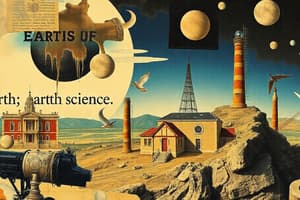Podcast
Questions and Answers
Which type of radioactive decay involves the emission of a high-energy photon, but no change in the number of protons or neutrons in the nucleus?
Which type of radioactive decay involves the emission of a high-energy photon, but no change in the number of protons or neutrons in the nucleus?
- Alpha decay
- Gamma decay (correct)
- Beta decay
- Radiocarbon decay
What is the primary principle behind radiometric dating?
What is the primary principle behind radiometric dating?
- Analyzing the ratio of parent radioactive isotopes to daughter decay products. (correct)
- Observing the layers of sedimentary rock and their relative positions.
- Comparing the chemical composition of rocks to estimate their formation time.
- Measuring the size and shape of fossils to determine their age.
Which factor is MOST crucial for the preservation of fossils?
Which factor is MOST crucial for the preservation of fossils?
- Presence of soft body parts that easily fossilize over time.
- Exposure to warm, moist conditions to accelerate decomposition.
- Slow burial in an open area to allow for gradual mineralization.
- Rapid burial to protect the organism from scavengers and weathering. (correct)
What characteristic is NOT typically associated with index fossils?
What characteristic is NOT typically associated with index fossils?
According to the principle of superposition, in an undisturbed sequence of sedimentary rocks, where are the oldest rock layers located?
According to the principle of superposition, in an undisturbed sequence of sedimentary rocks, where are the oldest rock layers located?
Which dating method is MOST suitable for determining the age of very old rocks, potentially billions of years old?
Which dating method is MOST suitable for determining the age of very old rocks, potentially billions of years old?
Which principle of relative dating states that rock layers are initially deposited in horizontal layers?
Which principle of relative dating states that rock layers are initially deposited in horizontal layers?
Radiometric dating is primarily based on the:
Radiometric dating is primarily based on the:
In geological studies, relative dating is often used to:
In geological studies, relative dating is often used to:
Georges Cuvier, a proponent of catastrophism, primarily based his theories on:
Georges Cuvier, a proponent of catastrophism, primarily based his theories on:
An unconformity in rock layers represents:
An unconformity in rock layers represents:
Which geological era is recognized as the 'age of mammals'?
Which geological era is recognized as the 'age of mammals'?
The principle of cross-cutting relationships states that:
The principle of cross-cutting relationships states that:
Uniformitarianism, as proposed by Charles Lyell, emphasizes that Earth's geological features are primarily shaped by:
Uniformitarianism, as proposed by Charles Lyell, emphasizes that Earth's geological features are primarily shaped by:
Fossil succession, a relative dating method, relies on the principle that:
Fossil succession, a relative dating method, relies on the principle that:
When scientists use both relative and numerical dating methods, they typically use relative dating first to:
When scientists use both relative and numerical dating methods, they typically use relative dating first to:
Which learning style utilizes previously acquired knowledge to comprehend new information?
Which learning style utilizes previously acquired knowledge to comprehend new information?
What does the 'International System of Units (SI)' represent?
What does the 'International System of Units (SI)' represent?
In the scientific method, what is the purpose of 'background' research?
In the scientific method, what is the purpose of 'background' research?
Which type of graph is most suitable for demonstrating small changes in a trend over time?
Which type of graph is most suitable for demonstrating small changes in a trend over time?
What is the largest division of the geologic time scale?
What is the largest division of the geologic time scale?
If a hypothesis is repeatedly supported by empirical research, what can it potentially become?
If a hypothesis is repeatedly supported by empirical research, what can it potentially become?
What does the dependent variable represent in an experiment?
What does the dependent variable represent in an experiment?
How is the 'Precambrian' period characterized in the geologic time scale?
How is the 'Precambrian' period characterized in the geologic time scale?
Which of the following is the most accurate definition of Earth science?
Which of the following is the most accurate definition of Earth science?
What are the main branches of Earth science?
What are the main branches of Earth science?
What is the focus of historical geology?
What is the focus of historical geology?
Which specialties within geology help us understand earthquakes and volcanoes?
Which specialties within geology help us understand earthquakes and volcanoes?
What role do meteorologists play in our understanding of weather?
What role do meteorologists play in our understanding of weather?
Why are Greek and Latin languages significant in scientific terminology?
Why are Greek and Latin languages significant in scientific terminology?
Flashcards
Earth Science
Earth Science
The study of Earth and neighboring planets, including their processes and history.
Geology
Geology
The branch of Earth science focused on the study of Earth, its structure, and processes.
Meteorology
Meteorology
The study of weather, climate, and atmospheric conditions.
Oceanography
Oceanography
Signup and view all the flashcards
Physical Geology
Physical Geology
Signup and view all the flashcards
Prefixes and Suffixes
Prefixes and Suffixes
Signup and view all the flashcards
Parent Nuclide
Parent Nuclide
Signup and view all the flashcards
Daughter Nuclide
Daughter Nuclide
Signup and view all the flashcards
Alpha Decay
Alpha Decay
Signup and view all the flashcards
Beta Decay
Beta Decay
Signup and view all the flashcards
Radiometric Dating
Radiometric Dating
Signup and view all the flashcards
Index Fossils
Index Fossils
Signup and view all the flashcards
Scientific Method
Scientific Method
Signup and view all the flashcards
Hypothesis
Hypothesis
Signup and view all the flashcards
Independent Variable
Independent Variable
Signup and view all the flashcards
Dependent Variable
Dependent Variable
Signup and view all the flashcards
Empirical Data
Empirical Data
Signup and view all the flashcards
Experimental Design
Experimental Design
Signup and view all the flashcards
Geologic Time Scale
Geologic Time Scale
Signup and view all the flashcards
Biases
Biases
Signup and view all the flashcards
Relative Age Dating
Relative Age Dating
Signup and view all the flashcards
Absolute Age Dating
Absolute Age Dating
Signup and view all the flashcards
Law of Superposition
Law of Superposition
Signup and view all the flashcards
Uniformitarianism
Uniformitarianism
Signup and view all the flashcards
Catastrophism
Catastrophism
Signup and view all the flashcards
Fossil Succession
Fossil Succession
Signup and view all the flashcards
Stratigraphic Succession
Stratigraphic Succession
Signup and view all the flashcards
Unconformity
Unconformity
Signup and view all the flashcards
Study Notes
Branches of Earth Science
- Earth science studies Earth and neighbouring planets, historical events, and formation processes.
- Four main branches:
- Geology: Study of Earth. Further divided into physical and historical geology.
- Physical geology: Earth's structure, form, and components.
- Historical geology: Earth's formation and life's development.
- Specialities: Seismology (earthquakes) and volcanology (volcanoes).
- Meteorology: Study of weather, atmosphere, and climate.
- Oceanography: Study of oceans, tides, waves, processes, and their role in climate change.
- Astronomy: Study of the universe.
- Geology: Study of Earth. Further divided into physical and historical geology.
Scientific Terminology
- Much scientific vocabulary comes from Greek and Latin.
- Greek roots are often in early scientific research.
- Latin is often used in naming organisms.
- Word parts (prefixes, roots, suffixes) aid understanding complex terms.
- Root: the primary part of a word.
- Prefix: appears before the root.
- Suffix: appears after the root.
Learning Styles
- Auditory: Learning through hearing.
- Visual: Learning through sight (images, charts).
- Hands-on: Learning through practical experience.
- Holistic: Using prior knowledge to understand new concepts.
- Analytic: Breaking concepts into smaller parts.
Scientific Method
- Series of steps to answer scientific questions.
- Steps may vary depending on the experiment and discipline.
- Key components:
- Question: The problem being investigated.
- Background Research: Previous relevant data.
- Hypothesis: Potential answer (testable).
- Experiment: Test to answer the question.
- Empirical Data: Information gathered through observation.
- Conclusion: Accepting or rejecting the hypothesis based on data.
- Independent Variable: The tested factor.
- Dependent Variable: The measured factor.
- Significance: Statistical meaning of the results.
- Peer Review: Evaluation by other scientists.
- Scientific Theory: Hypothesis supported by evidence.
- Biases: Potential for prejudice towards a result.
- Steps to using the scientific method:
- Ask a Question
- Research Background
- Formulate a Hypothesis
- Design and Conduct an Experiment
- Collect and Evaluate Data
- Accept/Reject hypothesis
- Formulate a new hypothesis if necessary
Experimental Design
- Crucial process in science to validate hypotheses.
- Follows a structured approach with five steps.
- Steps:
- Define variables.
- Formulate hypotheses.
- Design an experiment.
- Assign subjects.
- Measure the dependent variable.
International System of Units (SI / Metric System)
- Decimal system based on a factor of 10.
- Uses prefixes to denote large/small quantities.
- Key SI units:
- Length: meter
- Mass: kilogram
- Volume: cubic meter
- Density: kilograms per cubic meter
- Temperature: Kelvin
- Conversion factors are used for metric/English conversions.
Scientific Experiments and Data Display
- Six steps: Observe, form a hypothesis, design/conduct experiment, collect/evaluate data, accept/reject hypothesis, and create a new hypothesis if needed.
- Data displayed in various ways:
- Line graphs: Comparing trends over time (numerical data).
- Bar charts: Comparing data among groups (numerical and categorical).
- Pie charts: Showing percentages (numerical and categorical).
- Flow charts: Describing relationships/processes (non-numerical data).
Geologic Time Scale
- Earth's history categorized into units based on events/organisms.
- Four largest divisions: eons (eon, singular).
- Precambrian eon (early eons) until the emergence of multicellular organisms.
- Phanerozoic eon (recent eon)
- Eons are subdivided into: Eras, Periods, Epochs
- Stratigraphy: Study of rock layers to understand Earth's history.
- Relative age dating: Determining age based on relationships.
- Absolute age dating: Using radiometric measurements to determine exact age.
Catastrophism and Uniformitarianism
- Catastrophism: Sudden, violent events shape Earth's surface.
- Uniformitarianism: Gradual, observable processes are key.
- Modern view: Uniformitarian processes are dominant but interrupted by global cataclysms.
Radioactive Dating
- Radiometric dating (radioactive dating): Determining age from known decay rates of radioactive isotopes.
- Parent nuclide: The unstable original isotope.
- Daughter nuclide: The stable isotope formed by decay.
- Types of decay:
- Alpha decay: Alpha particle (Helium nucleus) emitted.
- Beta decay: Electron emitted, neutron turns into a proton.
- Gamma decay: High-energy photon emitted, no particle change.
- Half-life: Time for half of the radioactive material to decay.
Fossil Preservation
- Fossils: Remains or traces of ancient organisms.
- Factors affecting preservation:
- Rapid burial
- Hard parts
- Environment (Elements)
Index Fossils
- Index fossils: Distinctive, widespread fossils from a limited time span.
- Principle of fossil succession: Orderly arrangement of fossils in rocks.
- Correlating rock layers and establishing geologic time frames.
Periodic Table
- Organized model of all known elements.
- Arranging elements based on number of protons (atomic number).
- Periods (horizontal rows) and Groups (vertical columns).
- Metals, nonmetals, and metalloids.
- Trends in the periodic table help to predict element properties.
Types of Matter
- Elements: Pure substance composed of identical atoms.
- Molecules: Atoms chemically bonded together.
- Ionic bonds: Electrons transferred from one atom to another.
- Covalent bonds: Electrons shared between atoms.
- Non-polar: Equal sharing
- Polar: Uneven sharing
- Metallic bonds: Between metal atoms using a "sea of electrons".
- Hydrogen bonds: Bonds between hydrogen atoms to other atoms with a dipole.
- Compounds: Two or more elements chemically combined.
- Mixtures: Two or more substances physically combined.
- States of matter: Solid, liquid, gas, plasma, transition (fusion, evaporation...).
Physical and Chemical Properties of Matter
- Physical properties describe matter without changing its composition.
- Chemical properties describe how matter changes its composition.
- Pure substances: Elements and compounds.
- Mixtures: combinations of compounds and/or elements.
Studying That Suits You
Use AI to generate personalized quizzes and flashcards to suit your learning preferences.




